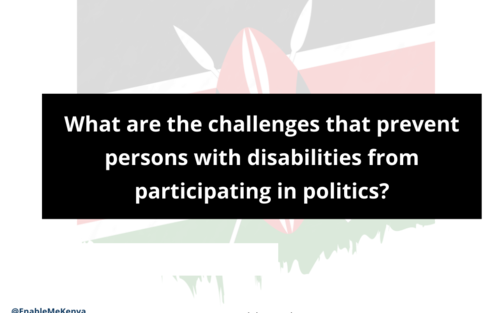The five barriers are:
1. Attitudinal barriers:
Culture, perception stigma and discrimination. The society views persons with disabilities differently and underestimate their capacities. They are also frequently labelled and called names which they don’t deserve. Lack of engagement in mainstream media discussions also affects participation, thus disability does not become a priority. The political scenery is also lacking of opportunities for persons with disabilities through the belief that they are not visible thus political parties tend to rely on a few individuals with disabilities. Persons with disabilities themselves have minimal life skill competences thus most lack to participate due to societal believes that make them not to contribute. Another compelling factor is the lack of education among persons with disabilities thus making contribution.
2. Environmental barriers: This is in reference to physical access. This is very common in the political spaces where we conduct political activities, campaign venues transport and around most built environment. This becomes a hazard can also contribute to insecurity and violence. It is evidenced that when political forums happen in some venues, they turn violent thus making persons with disabilities not to attend.
3. Communication barrier: This affect all Kenyans with sensory impairments, cognitive disabilities where by materials are not in alternative formats. Communication materials are located in far distance not reachable. For example, persons with short stature cannot read high posters.
4. Institutional barriers: these are the policies which affect persons with disabilities. For instance, the new political act 2021 doesn’t communicate how persons with disabilities are affected by the coalition partnerships. Lack of data on persons with disabilities thus making stakeholders not to plan.
5. Financial barrier: This is one which inhibits participation of persons with disabilities. The poverty levels among persons with disabilities is a clear indicator that makes them not to participate. Most political parties are funded by individuals in Kenya despite having the political party funds. Economic Resources required in political activities like campaigns are very expensive
Current situation in Kenya:
There is formation of amorphous groupings called the disability leagues which act as the bridge between political parties a person with disabilities.
In 2022 they have been vocal in media houses, attending forums and development of party policies and ensuring more persons with disabilities become members. The disability league experience lack of systems and measure to institutionalize and most of them are run by the established politicians with disabilities. They have desks not fully having offices.
What can persons with disabilities and political parties improve:
- Build more capacity for persons with disabilities to understand the role of political parties.
- Institutionalize the disability leagues and also promote county chapters more.
- Empowering persons with disabilities economically

